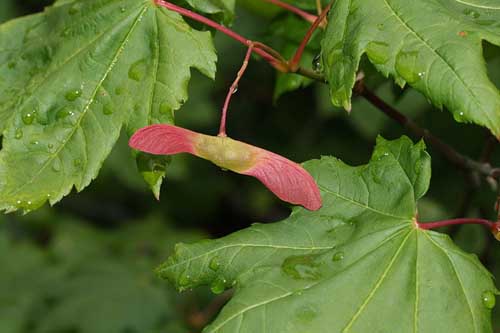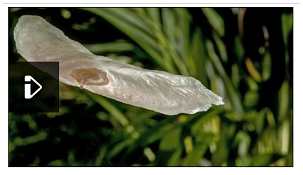 |
 |
| Home | Welcome | What's New | Site Map | Glossary | Weather Doctor Amazon Store | Book Store | Accolades | Email Us |
 | |||||||||||||
Weather Almanac for May 2011SOWING WITH THE WINDWhen I first arrived in Valemount BC five years ago, Spring was beginning to burst out, and the air was often filled with the fecundity of nature. The yellow pollens from the aspen and birch moved in clouds across the foothills and after a rain formed a golden ring around every puddle. Closer to the ground, the strong valley winds raised the seeds of dandelion into a flurry of white as they danced with the breeze across the landscape.
Besides being the product of sexual reproduction of plant and fungus species, seeds and spores allow the young plant to move away from the parent plant (a common desire for all parents). Seed/spore dispersal through one of several mechanisms gives the embryo-bearing seed a chance to establish the new entity away from the parent that avoids both parent and child competing for the same water, nutrient and light resources. In addition to dispersal by the wind, seeds/spores may disperse through drifting away in moving water, both fresh and salty, or through catching a lift from animals through either ingestion (and surviving a trip through the gut to be defecated hopefully some distance way) or by physically attaching to the animal, much as pollens use bees and other pollinators. Borne on the WindsThe ever-constant winds provide an ideal mechanism for the dispersion of seeds and spores across vast territories. And here, we do not limit ourselves to the horizontal wind flow because the vertical winds, particularly those ascending, provide an important mechanism for the dispersal of many seeds/spores over vast distances. Turbulence of the wind in the lower atmosphere also can push seeds/spores high into the sky, and thus facilitate long distance dispersal. For example, a dandelion seed may be detached from its parental stalk by a strong wind or the action of an animal walking nearby. Once detached, the seed must gain altitude to catch the wind field that will move it away from its parent. A seed detached during calm conditions, by animal or rainfall, would fall near its parent and be forced to compete with it for water and nutrients. But if the wind near the surface was turbulent, the seed would have a better chance of rising above the surface layer and into the stronger wind field above. There, either mechanical turbulence in the wind caused by terrain and vegetation or thermal turbulence caused by the strong heating of the surface may loft a seed high into the sky for a longer ride. Within a forest canopy, seeds and spores can be moved around by the turbulent wind field that arises from the wind blowing through the forest. One feature of fungi or fern spores is that they are very small and light, and thus do not require strong winds to move them about. The price they pay for that lightness is the lack of a nutrition supply. (One of the main differences between a seed and a spore is that the seed carries a “food” reserve that allows the embryo to survive longer and have a supply of nutrients to establish the seedling before its chlorophyll begins making nutrition.) Spore-n on the Winds(Sorry for the pun.) Several life forms use spores to reproduce their species including many bacteria, some protozoa, algae, some plants such as ferns and mosses, and fungi. One common characteristic in many of these is that they produce incredible numbers of spores in the hopes that a few will become established and grow to reproductive stage. As examples, I present the pathogenic fungi corn smut (Ustiago maydis) and the woody fungus Ganoderma applanatum (also known as the artist’s fungus). When matured, corn smut develops black galls about a cubic inch in size that contain around 25 billion spores each. And an infected plot of corn may contain thousands of such galls that will release their spores into the wind. The artist fungus releases spores continually during the active season through tubules on its underside. An annual release can number 5.4 trillion spores over a six-month period.
Many of the fungi species produce spores that are called dry spores because they are hydrophobic. This property allows the spores to be released by the force of rain hitting the fruiting body and remain dry, and thus light, as they drift away with the wind. The light weight allows spores to be swirled around under very light winds, thus increasing the chances of finding a preferred landing site for the establishment of the new fungus. The spores of Ganaderma, for example, must fall within a wound on a tree to enter the wood where they will germinate. The measurement of air samples indicate that as many as 200,000 spores may be found in a cubic metre of air. A study conducted in 1937 in Minnesota and the Dakotas estimated that thousands of tons of spores from the fungi Cladosporium and Penicillum were present in the airstreams that blew eastward across North America and possibly over the Atlantic. We know that large-scale wind streams transport spores of wheat rust (Puccinia graminis) from northern Mexico over the American Plains as far north as the Canadian Prairies. The offspring of later generations eventually move with the winds back south in the autumn to the winter wheat growing regions of the southern US and northern Mexico. Spores can remain aloft for a very long time due to their lightness. As an example, spores of the genus Sphagnum measure from 22 to 45 micrometres in size and thus fall in still air at a rate of 0.5 to 2 cm/s (0.2 to 0.8 inches/s). Therefore, if a spore reached an altitude of 3 metres (about 10 ft) before freely descending, it would take over 2.5 minutes before it fell to earth (assuming vertical currents did not keep it aloft). In a light breeze of 10 km/h (about 6 mph), the spore could flow downwind over 400 metres (a quarter mile). Spores can can attain high altitudes, often reaching the penultimate regions of thunderstorm complexes and this great height allows them to travel long distances on the global air currents,. Balloon measurement of spore content in the air in 1935 found viable spores at elevations between 11,000 and 21,600 metres (36,000 - 71,000 feet). At these heights, the winds can blow steadily at 100 km/h (60 mph) or more, and thus a cloud of spores caught in such an airstream could travel as much as 16,000 km (10,000 miles) in a week. Many spore-producing bodies grow low to the ground and thus face the task of introducing their spores into airstream at heights that will allow them to be caught in the wind stream and lofted above the surface layer of air. Species of the ascomycete fungi, commonly known as the Sac fungi, have evolved a special mechanism to add in their spore’s quest for altitude: they shoot them skyward in a single explosion of spores during periods favorable for dispersion. Chains of spores or conidia are dispersed from a growing colony of moldThe spores of peat moss are shot into the air with an air-gun-like mechanism that projects them from 10 to 20 cm (4 to 8 inches) above from the plant. Thus, the small, light spores are able to rise further above the surface and are more likely to be caught in the turbulent surface wind field and dispersed away from the parent. Seeds of Flight
All but the smallest seeds are too heavy to blow far from their parent except in the strongest winds, so many plants have evolved mechanical aids to “fly” their seeds further away from the flower. Some of these efficient mechanisms have been adapted by other life forms and by humans (hence the popular names for them). The most common can be categorized as hairiness, parachutes, gliders, and helicopters. One special class of plants which uses the wind to disperse seeds do not send their seeds airborne, but sow their seeds while the whole plant is transported by the wind, usually bouncing along the ground. Such plants are commonly referred to as tumbleweeds.” The basic process of wind dispersal depends on a number of factors that includes:
In the ideal situation, a seed would fall slowly after release from a great height into a fast wind stream with strong upward motions and no precipitation. In individual cases, wind direction may also be important, particularly if the wind blows toward fertile ground or previously uncolonized terrain.  Acer circinatum or Vine Maple. Photo by Walter SiegmundTrees obviously have the height advantage over shorter species such as dandelions. In a simple trajectory example, a seed falling from a 10-m (33 ft) tall tree would land 20 times further downwind than a similar on released from a 0.5-m (1.25 ft) tall herbaceous plant (assuming the rate of fall and all other conditions are the same). With the same scenario, the distance the seed would travel before hitting ground is twice as far under a wind speed twice as fast, and we know that wind speed generally increases with height. There are practical limits to how tall a particular species can grow and how fast the wind can blow without destroying the plant. So if a seed is to fall far from its parent, it would be advantageous to have some mechanism to keep it aloft. Dust-sized seeds, such as those of many members of the grass family, can travel great, even intercontinental, distances if they are lofted high into the sky, but seeds having a small size cannot carry much “food” to establish the seed once it falls to earth. Larger seeds can travel long distances in the air when enhanced by mechanical devices such as hairy, parachute, glider, and helicopter forms. Many plants that disperse seeds through the wind use a form of hairiness. Most often, this manifests as fluffy or cottony masses of hairs surrounding the seed mass or attaching on one end (tufts). These hairs increase the aerodynamic drag of the seed, which slows its earthward fall rate and thus increases a seed’s chance to be caught by turbulent winds and lofted higher into the sky. Plants that use this mechanism include the willows and cottonwoods; the sycamores; the cattails; the willow-herb; the kapok tree; and the floss silk tree. At times, releases of such seeds, say from a cattail marsh or cottonwood grove, can fill the sky with floating seed clouds and resemble snowfall when they cover the ground en mass. “Parachute” seeds such as found in that bane of the American lawn, the common dandelion, have fuzzy hairs arranged like an umbrella fastened on one end of the seed. The parachute not only reduces a seed’s descent rate but also provides an apparatus that increases the seed’s chance of being caught by the turbulent surface wind and lofted by mechanical and thermal turbulence updrafts to fly for great distances downwind. In addition to the dandelion, some milkweeds, bulrushes, salsify, daisy and sunflower species as well as the thistle artichoke use parachutes to aid in seed dispersal. “Helicopter” or “whirlybirds” seeds, technically known as samara, have a rigid membrane attached to the seed that resembles a fan blade. As the seed falls, the blade rotates the seed with a motion that decreases the fall rate and thus allows the seed to be pushed by surrounding winds some distance from the parent tree. For these, the wind speed at time of release and the height of release are more important in determining the dispersal than for the parachute seeds, and thus most helicopter seeds are released by tree species. Maple trees are perhaps the best known of the winged seeders but other tree species including the box elder, olive, birch, ash, and some cone-bearing species of pine, fir, spruce and hemlock also form such seeds as do a few of the legume family. (Though we usually think of the legumes as the bean family, but locust trees and wisteria are also members.) Those members of the Pine family shed their winged seeds from cones high on their upper branches. This allows the seeds to cross mountain ridges and deep canyons. Birch is a well-known pioneer species that colonizes bare sites rapidly and in large numbers after a denuding by wildfire. Birches were among the first tree species to reclaim the tundra after the great continental glaciers retreated at the end of the last Ice Age. “Glider” seeds differ from helicopter seeds in that they have two lateral wings on the seed that allows the released seed to glide like a paper airplane when released. Some suggest some of this group inspired the shape of the Stealth bomber and other aircraft which they resemble. The most striking example of the glider seed is released from a tropical vine of the gourd family, the Alsomitra macrocarpa, a type of climbing gourd, also known as the Javan cucumber. These vines produce large gourds, the size of a soccer/football, high in the tropical forest canopy. Each gourd holds up to 400 winged seeds packed in layers. When the seed breaks away it has a wingspan of as much as 15 cm (six inches) across, and yet the wings are marvelously thin, less than 10 micrometres. As they fall, at a rate less than half that of most winged seeds, they glide away from the vine and generally land within 6 metres (20 ft) of the parent, though under some conditions they can glide considerable further.  A BBC video of the falling glider seed can be found The final group of wind-dispersed seed is the “tumbleweed,” a general name often applied in the American West to the non-native species, the Russian thistle. In contrast to the wind dispersal of the seeds previously mentioned, the tumbleweed itself is the carrier mechanism. A prolific seed producer, the tumbleweed sets from 20,000 to 50,000 seeds per plant in the brief wet season. When seeds have been set, the parent plant will easily break its stalk at ground level and under strong and gusty winds sets out on a tumbling journey across the dry landscape. As the plant tumbles and rolls, the jostling releases the seeds, which fall to earth ready for germination. While the vast majority of wind-blown seeds fall only a short distance from their parent, some may catch an advantageous wind and soar high and far from their origin. Some, such as birch seeds, may become colonizers when they fall in new territories far from their home population, this often is the case with exotic species brought in by humans for ornamentation or agricultural uses. Far-ranging seeds may recolonize areas denuded by wildfires with species destroyed in the blaze. In some situations, the thermal updrafts created over bare ground or newly burned terrain may assist in lofting seeds many kilometres from the original population. Some species have taken advantage of a more modern aerial transportation mechanism: hitching a ride on an aircraft, either through adhering to the craft’s outer surface or the passengers and cargo to eventually be released a some far distant location. How many exotic and now pest species have hitched a ride in this manner? Learn More About Weather From These Relevant Books
|
|||||||||||||
 |
Now AvailableThe Field Guide to Natural Phenomena: |
Available! Order Today! | |
 |
 |
Now |
The BC Weather Book: |


